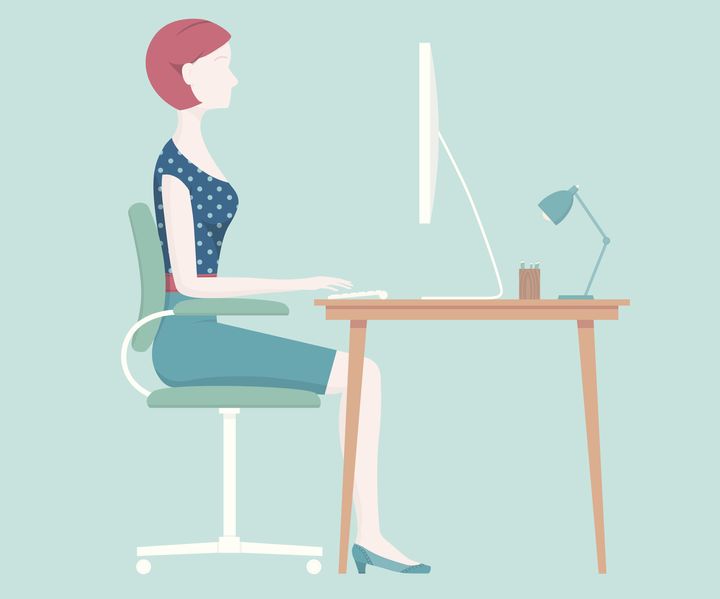Many of us have been working from home for months – but without the chair we usually have in the office, or the double screens some of us are lucky to use, it can be a bit... achey, to say the least.
Find yourself hunching over to look at your laptop screen? Or constantly rearranging yourself on your chair because it’s just so uncomfortable? You’re not alone.
“Most of us found ourselves unexpectedly working from home for the foreseeable future,” says Jo Blood, resident ergonomics expert at Posture People. “Whilst it poses many challenges, a well set-up workspace is something that can provide us with a tangible way to feel better and prevent aches and pains further down the line. For the time being, we can utilise everyday household items to achieve a better, more ergonomic workspace.”

Here, posture and ergonomics experts explain the hacks you can use to make WFH a little bit more comfortable.
Raise your laptop so you aren’t hunched. “This is the biggest back problem,” says Jane Sparrow, remote working expert and founder at The Culture Builders. Work at a surface that keeps it high, or bung a load of books underneath it. As a rule of thumb, Blood says you want to raise it so that the top of your laptop screen is in line with your eyebrows.
A laptop stand is a great alternative to books, if you have one or are willing to buy one. Or, Bronwyn Clifford, chartered physiotherapist and ergonomics Consultant at Ergo at Work suggests using a lever arch file/folder. “These make fantastic laptop risers allowing you to raise the laptop screen slightly when working,” she says. “They can be used when sitting at a table or on even a sofa. If sitting on a sofa raise the laptop on a cushion as well as a lever arch file to help you to keep your head back over your shoulders in a neutral position.”
Use cushions as a bumper. “Your kitchen table is the perfect place to work, but be aware that the average table is around 3cm higher than your desk, and your kitchen chair 3cm lower,” says Blood. “Make up for this deficit by using cushions to support your lumbar and pad the bottom of the chair. You’ll know you’re sitting at the right height by making sure that, with shoulders relaxed, your forearms run parallel to the table. If your feet don’t touch the floor when you’ve found the right height, use a chunky book to rest your feet on as this will take the pressure off your thighs and hips.”
Try standing and working occasionally. If you can pop your laptop up on a breakfast bar or work surface, great. If not, you’ll need to improvise. How about getting out that ironing board from the cupboard and using it as a stand-up desk? Clifford suggests trying the top of a chest of drawers of book shelf. “A large box placed on top of the kitchen bench can also work well,” she says.
Buy a lap desk. If you don’t have anywhere to sit at a table, and you’re stuck with the bed of sofa, try a portable desk. Many of these are foldable and adaptable at different heights.
Walk when you’re on a call. Sparrow suggests taking a trip around the house when you’re on the phone to someone. “I do this a lot and it keeps energy up and allows your eyes to rest from the video calls or screen work if you look out of the window during the walking,” she says.
Post-it note reminders. “Put a post-in on the side of your laptop that says ‘sit up’ and when you notice it, straighten your back,” says Sparrow.
Try to resist the sofa. “If you work on a laptop on your sofa, you’ll have to crane your neck to look down which will cause all manor of neck, back and shoulder pain in the long run,” says Blood.
Get a keyboard and mouse. If you’re willing to splash a bit of cash, buy a keyboard and raise your laptop even higher – to eye level. “Make sure you use a keyboard and mouse positioned close to you after you’ve raised your laptop to stop yourself over-extending your arms and shoulders,” says Blood.
Alternate chairs. The best place to sit is in a good quality office chair. But if that’s not possible, try alternating chairs, says Sparrow. From a dining chair to a stool, for example, to change things up a bit.
And also remember to...
:: Take regular breaks and stretch your whole body.
:: Try and give yourself a nice outlook – if you can, locate yourself near a window for natural light and a view.
If you are struggling with your set up, approach your employer about it if you feel comfortable doing so. They might be able to support you better.